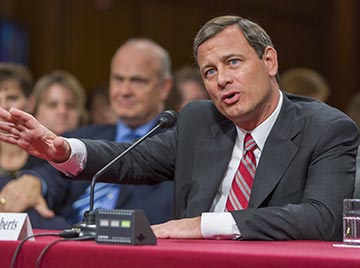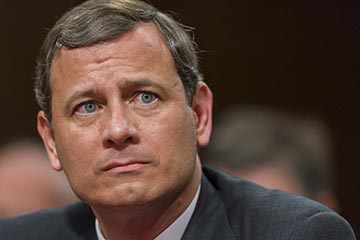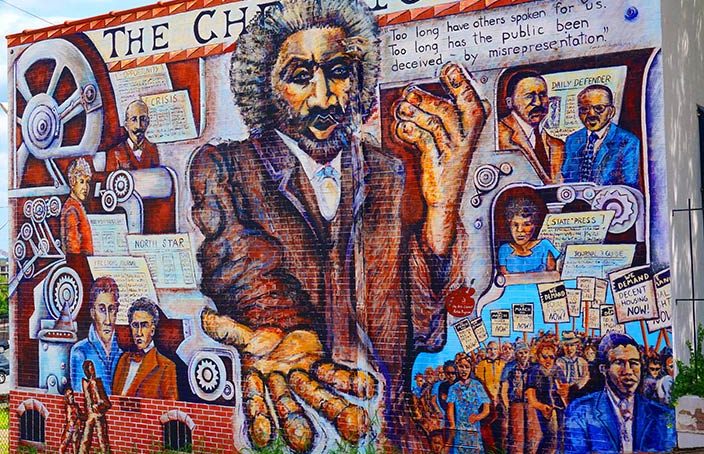Will John Roberts Swing Left on Key Voting Rights Cases?
By Susan Caba
Everything we hear is an opinion, not a fact. Everything we see is a perspective, not the truth.
– Marcus Aurelius, Emperor of Rome
Chief Justice John G. Roberts Jr. is now considered a possible—but not probable—swing vote in what the Washington Post calls “two of the most politically consequential decisions the Supreme Court has made in years.” Decisions are expected in the next several days.

Supreme Court Chief Justice John Roberts Jr. is now a potential “swing” vote in 5-4 decisions.
But he did just that in one notable case. In 2012, Roberts cast his vote with the liberals, upholding the constitutionality of Affordable Care Act—outraging conservatives who challenged what is commonly called Obamacare. Will he do it again?
The Chief Justice is a reliable conservative vote. He’s one of a five-justice conservative majority solidified by President Donald Trump with the appointments of Neil Gorsuch and Brent M. Kavanaugh. But Roberts is also ardently protective of the Court’s somewhat frayed reputation as an independent arm of government. He bristles at any suggestion the Court splits along partisan lines, with the Republican-appointed justices being conservative and the Democrat-appointees consistently left-leaning.
When President Trump lambasted “Obama judges” for a decision that didn’t go his way, Roberts publicly rebuked him: “We do not have Obama judges or Trump judges, Bush judges or Clinton judges.”
“Roberts is the most interesting judicial conservative in living memory because he is both ideologically outspoken and willing to break with ideology in a moment of great political consequence,” Michael O’Donnell wrote in the Atlantic. “His response to the constitutional crisis that awaits will define not just his legacy, but the Supreme Court’s as well.”
When he was appointed in 2005, no one would describe Roberts as a swing vote. According to FiveThirtyEight, which covers politics based on statistics, Roberts cast the pivotal vote in just five cases in which the liberals were in the majority during his first 12 years. Only the health care case was significant. He’s voted to establish individual gun ownership rights, to loosen campaign finance restrictions, and to gut the Voting Rights Act.
But times—and justices—change.
Roberts’ new status as a potential swing voter has more to do with his position on the Courts’ spectrum of conservatives than with any moderation in his outlook. Justices appointed by Republican presidents since Clarence Thomas took the bench in 1991 are increasingly more conservative than their predecessors. And younger, too—the conservative majority is likely to hold for decades, even if Democrats get to fill the next four vacancies.
The two decisions about to be announced present Roberts with a choice similar to the health care issue — vote his presumed conservative opinion, or cast his vote with the liberal contingent to encourage public confidence in the Court. (In reality, most 5-4 decisions do split along party lines. Political scientists deemed the Roberts Court the most conservative in several decades.) It’s commonly believed that Roberts weighed the impact on the Court’s reputation when he voted to uphold Obamacare.
Of course, he could split the baby and vote to uphold lower court decisions in one case, but not the other. If so, the Chief Justice may decide based on which vote would cause the least outrage among conservatives—or, considering his career-long history of trying to restrict voting access, which would have the biggest impact over the long term.
The census case, is at the moment, limited to deciding whether Commerce Secretary Wilbur Ross has the authority to add a question about citizenship to the census. That might make it more palatable for Roberts to strike down. But controversial new evidence came to light that indicates Ross knew that adding the question would create an advantage for Republicans and non-Hispanic whites. That could complicate his decision.

Chief Justice John G. Roberts has a history of working to restrict voting rights.
Roberts prefers to pull the court to the right at a measured pace, while defending the Court’s independence. After the very partisan and contentious confirmation hearings that elevated Kavanaugh, the Chief Justice made a rare public statement.
“We do not sit on opposite sides of an aisle, we do not caucus in separate rooms, we do not serve one party or one interest, we serve one nation.”
The decisions about to be announced may also reveal if there is any substance to his declaration.
Further Reading
John Roberts: The Boy in the Bubble, Washington Monthly
The chief justice has made a career of undoing progress on civil rights and ignoring the consequences.
John Roberts Has Cast A Pivotal Liberal Vote Only 5 Times, fivethirtyeight.com
The court’s new median justice isn’t very swingy.
John Roberts, Leader of Supreme Court’s Conservative Majority, Fights Perception That It Is Partisan, NY Times
John Roberts’s Chance for Greatness, The Atlantic
As Kavanaugh tips the Court further to the right, the chief justice will have to decide whether the Court will dictate social policy from the bench.
SCOTUS 101: Is John Roberts the New Swing Vote?, The Heritage Foundation
Susan Caba is an independent journalist who writes about politics, popular culture and leadership. She is the author of The Complete Idiot’s Guide to Leadership, Fast Track.

